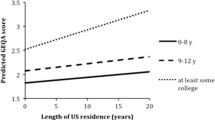Abstract
This study examined the relationship between acculturation and obesity in foreign-born Asians residing in the United States, using the 2009 California Health Interview Survey secondary data (N = 2,871). Two series of proxies and/or behavioral variables were used to measure level of acculturation: (a) length of US residency (years and percent of life) and (b) English language use and proficiency. It was hypothesized that acculturation measured with both proxies would positively predict obesity among foreign-born Asian adults who live in the United States. Results did not support the relationship between obesity and residency length, and greater English use and proficiency seemed to predict lower obesity. However, additional exploratory analysis was performed for each Asian ethnicity and the results showed that the hypothesized links were partly supported for Filipino subgroup, but the links for Vietnamese subgroup were in the opposite direction of the hypotheses and inconsistent with previous literature.




Similar content being viewed by others
References
World Health Organization. WHO: Global database on body mass index. 2011 (cited 2012 May 1). http://apps.who.int/bmi/index.jsp.
Centers for Disease Control and Prevention. Chronic disease—obesity at a glance. 2011 (cited 2011 Oct 26). http://www.cdc.gov/chronicdisease/resources/publications/aag/obesity.htm.
Asian American Alliance. Spread of obesity among Asian Americans. 2011 (cited 2011). http://www.asianamericanalliance.com/obesity.html.
Unger JB, et al. Acculturation, physical activity, and fast-food consumption among Asian-American and Hispanic adolescents. J Community Health. 2004;29(6):467–81.
Centers for Disease Control and Prevention. Halting the epidemic by making health easier at a glance. 2011 (cited 2012). http://www.cdc.gov/chronicdisease/resources/publications/aag/obesity.htm.
Weight-control Information Network. Overweight and obesity statistics. 2010 (cited 2012). http://win.niddk.nih.gov/statistics.
Office of the Surgeon General. The surgeon general’s call to action to prevent and decrease overweight and obesity. 2007 (cited 2012). http://www.surgeongeneral.gov/topics/obesity/calltoaction/fact_consequences.htm.
National Institutes of Health. Overweight and obesity statistics. 2011 (cited 2011). http://win.niddk.hih.gov/.
American Cancer Society. The obesity-cancer connection and what we can do about it. 2013 (cited 2014 March 13). http://www.cancer.org/cancer/news/expertvoices/post/2013/02/28/the-obesity-cancer-connection-and-what-we-can-do-about-it.aspx.
World Health Organization. WHO obesity and overweight. 2012 (cited 2012). http://www.who.int/mediacentre/factsheets/fs311/en/.
The Economist. Obesity rates: fat of the lands. 2010 (cited 2012 May 1). http://www.economist.com/node/17118939.
Development, O.f.E.C.a. Obesity and the economics of prevention: Fit not fat. 2010 (cited 2014 March 13). http://www.oecd.org/els/health-systems/obesityandtheeconomicsofpreventionfitnotfat.htm.
Wang Y, et al. Will all Americans become overweight or obese? Estimating the progression and cost of the U.S. obesity epidemic. Obesity. 2008;16(10):2323–30.
Centers for Disease Control and Prevention. Summary health statistics for U.S. adults: 2011. Table 31. 2012 (cited 2014). http://www.cdc.gov/nchs/data/series/sr_10/st10_256.pdf.
Centers for Disease Control and Prevention. Health characteristics of the Asian adult population of the United States, 2004–2006: Table 2. 2008 (cited 2014). http://www.cdc.gov/nchs/data/ad/ad394.pdf.
Satia-Abouta J, et al. Dietary acculturation: applications to nutrition research and dietetics. J Am Diet Assoc. 2002;102:1105–18.
Abraido-Lanza AF, Armbrister AN, Florez KR. Toward a theory driven model of acculturation in public health research. Am J Public Health. 2006;96(8):1342–6.
Gordon M. Assimilation in American: theory and reality, in notable selections in race and ethnicity, A.A.E. Baker, editor. Dushkin: Guilford, CT; 1995. p. 91–101.
Berry JW. Immigration, acculturation, and adptation. Appl Psychol Int Rev. 1997;46(1):5–33.
Lee L, Nguyen H, Tsui J. Interview language: a proxy measure for acculturation among Asian Americans in a population-based survey. J Immigr Minor Health. 2011;13(2):244–52.
Dey A, Lucas J. Physician and mental health characteristics of U.S. and foreign-born adults: United States, 1998–2003. Adv Data. 2006;369:1–19.
Popkin BM, Udry RJ. Adolescent obesity increases significantly in second and third generation U.S. immigrants: the National Longitudinal Study of Adolescent Health. J Nutr. 1998;128:701–6.
Novotny RD, et al. U.S. acculturation, food intake, and obesity among Asian-Pacific hotel workers. J Acad Nutr Diet. 2009;109(10):1712–8.
Wu-Tso P, Yeh IL, Tam CF. Comparisons of dietary intake in young and old Asian Americans: a two-generation study. Nutr Res. 1995;15(10):1445–62.
Liou D, Bauer K. Exploratory investigation of obesity risk and prevention in Chinese Americans. J Nutr Educ Behav. 2007;39(3):131–41.
Negy C, Woods DJ. The importance of acculturation in understanding research with Hispanic Americans. Hisp J Behav Sci. 1992;14(2):224–47.
Cabassa LJ. Measuring acculturation: where we are and where we need to go. Hisp J Behav Sci. 2003;25:125–46.
Antecol BK. Unhealthy assimilation: why do immigrants converge to American health status levels? Demography. 2006;43(2):337–60.
Lauderdale RP. Body mass index in a US national sample of Asian Americans: effects of nativity, years since immigration and socioeconomic status. Int J Obes Relat Metab Disord. 2000;24(9):1188–94.
Kaushal N. Adversities of acculturation? Prevalence of obesity among immigrants. J Health Econ. 2009;18(3):291–303.
Choi J, Thomas M. Predictive factors of acculturation attitudes and social support among Asian immigrants in the USA. Int J Soc Welf. 2009;18(1):76–84.
Wang S, Quan J, Fernandez A. Asian Americans and obesity in California: a protective effect of biculturalism. J Immigr Minor Health. 2011;13(2):276–83.
Wang Y, Beydoun MA. The obesity epidemic in the United States—gender, age, socioeconomic, racial/ethnic, and geographic characteristics: a systematic review and meta-regression analysis. Epidemiol Rev. 2007;29(1):6–28.
Sheu H, Bridging the international gap when counseling Aian and Asian American men. In: Liu MW, Iwamoto KD, Chae MH, editors. Culturally responsive counseling with Asian American men. Routledge Taylor and Francis Group: New York, NY; 2010. p. 299–317.
Iwamasa GY. Acculturation of Asian American university students. Assessment. 1996;3(1):99–102.
Yates A, Edman J, Aruguete M. Ethnic differences in BMI and body/self-dissatisfaction among Whites, Asian subgroups, Pacific Islanders, and African Americans. J Adolesc Health. 2004;34(4):300–7.
Gomez SL, et al. Immigration and acculturation in relation to health and health-related risk factors among specific Asian subgroups in a health maintenance organization. J Inf. 2004;94(1):1977–84.
Ea EE, et al. Job satisfaction and acculturation among Filipino registered nurses. J Nurs Scholarsh. 2008;40(1):46–51.
Salant T, Lauderdale DS. Measuring culture: a critical review of acculturation and health in Asian immigrant populations. Soc Sci Med. 2003;57(1):71–90.
Misra A. Revisions to cutoffs of body mass index to define overweight and obesity are needed for the Asian-ethnic groups. Int J Obes. 2003;27:1294–6.
Author information
Authors and Affiliations
Corresponding author
Rights and permissions
About this article
Cite this article
Nguyen, HH.D., Smith, C., Reynolds, G.L. et al. The Effect of Acculturation on Obesity Among Foreign-Born Asians Residing in the United States. J Immigrant Minority Health 17, 389–399 (2015). https://doi.org/10.1007/s10903-014-0027-6
Published:
Issue Date:
DOI: https://doi.org/10.1007/s10903-014-0027-6




